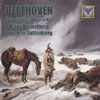Beethoven Symphonies Nos 3 & 8
Swelling dynamics induce feelings of seasickness, but if you can cope with the crossing, there are things worth hearing
View record and artist detailsRecord and Artist Details
Composer or Director: Ludwig van Beethoven
Label: Farao Classics
Magazine Review Date: 6/2000
Media Format: CD or Download
Media Runtime: 70
Mastering:
Stereo
DDD
Catalogue Number: B108026

Tracks:
| Composition | Artist Credit |
|---|---|
| Symphony No. 3, 'Eroica' |
Ludwig van Beethoven, Composer
Enoch zu Guttenberg, Conductor Ludwig van Beethoven, Composer Orchester der KlangVerwaltung |
| Symphony No. 8 |
Ludwig van Beethoven, Composer
Enoch zu Guttenberg, Conductor Ludwig van Beethoven, Composer Orchester der KlangVerwaltung |
Author: Rob Cowan
First encounters with Enoch zu Guttenberg's Eroica were mostly positive. Tempos are well chosen, energy levels high and there are novel interpretative ideas on offer. But repeated listening soon broke the spell. The enthusiastic period-instrument KlangVerwaltung copes bravely, though they tend to labour whenever zu Guttenberg pushes the pace (as he does in the Scherzo) and the recording is short on detail. There's no first-movement repeat (unusual for an 'authentic' Eroica) but the most maddening eccentricity relates to dynamics. Jabbing sforzandos are one thing, but when zu Guttenberg inserts a violent 'bulge' at the apex of a phrase - as he does here time and again - you find yourself being distracted from the principal arguments.
Admittedly, the bulging woodwind lines at 6'57'' into the opening movement stimulate the ear first time around. But why, with all this arching and surging going on, does zu Guttenberg fail to observe the crescendo that Beethoven places over the strings for the second subject of the Eroica's first movement (at 1'44'') ? The marching string triplets at 3'46'' into the Marcia funebre go merrily on their way (a novelty in itself), though the timps from 10'05'' thwack fairly dramatically thereafter. The finale's coda is almost comically lightweight.
The Eighth Symphony has its moments (nice woodwind/string exchanges in the second movement), and the first-movement repeat is played; but the vigorous opening gesture tails off to piano, almost as if it's a sort of afterthought. Again, there are just too many affectations and quirks of balance.
If you want a lively, clear-thinking period-instrument Eroica that's not part of an ongoing cycle, then Jordi Savall on Auvidis fits the bill perfectly. My personal favourite among 'authentic' Eroicas - a decidedly post-Furtwanglerian reading under Frans Bruggen (Philips, 11/88 - nla) - isn't currently listed, but if you don't mind a mixture of authentic textures and modern instruments, then there's always David Zinman on Arte Nova, an invigorating production with plenty to say, and very cheap.
'
Admittedly, the bulging woodwind lines at 6'57'' into the opening movement stimulate the ear first time around. But why, with all this arching and surging going on, does zu Guttenberg fail to observe the crescendo that Beethoven places over the strings for the second subject of the Eroica's first movement (at 1'44'') ? The marching string triplets at 3'46'' into the Marcia funebre go merrily on their way (a novelty in itself), though the timps from 10'05'' thwack fairly dramatically thereafter. The finale's coda is almost comically lightweight.
The Eighth Symphony has its moments (nice woodwind/string exchanges in the second movement), and the first-movement repeat is played; but the vigorous opening gesture tails off to piano, almost as if it's a sort of afterthought. Again, there are just too many affectations and quirks of balance.
If you want a lively, clear-thinking period-instrument Eroica that's not part of an ongoing cycle, then Jordi Savall on Auvidis fits the bill perfectly. My personal favourite among 'authentic' Eroicas - a decidedly post-Furtwanglerian reading under Frans Bruggen (Philips, 11/88 - nla) - isn't currently listed, but if you don't mind a mixture of authentic textures and modern instruments, then there's always David Zinman on Arte Nova, an invigorating production with plenty to say, and very cheap.
'
Discover the world's largest classical music catalogue with Presto Music.

Gramophone Digital Club
- Digital Edition
- Digital Archive
- Reviews Database
- Full website access
From £8.75 / month
Subscribe
Gramophone Full Club
- Print Edition
- Digital Edition
- Digital Archive
- Reviews Database
- Full website access
From £11.00 / month
Subscribe
If you are a library, university or other organisation that would be interested in an institutional subscription to Gramophone please click here for further information.




